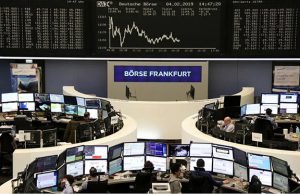Bloomberg
European equities and US stock-index futures fell amid signs central banks will turn more hawkish and as investors focused on earnings reports from Wall Street banks.
Contracts on the S&P 500 and Nasdaq 100 indexes slipped at least 0.3% each as US markets were set to reopen after a holiday. The Stoxx Europe 600 Index was dragged by technology and automobile-parts shares. Treasuries slid, with yield curves steepening. The dollar fluctuated between gains and losses, while gold declined. Freeport-McMoRan Inc. declined in premarket New York trading amid a muted
demand outlook for copper.
Investors had their expectations for a pause in central-bank tightening damped by European Central Bank (ECB) chief economist Philip Lane, who said interest rates will have to move into restrictive territory to bring inflation back to target. BlackRock Inc. Vice Chairman Philipp Hildebrand said he saw no chance of policy easing this year. Data including a record increase in UK wages signalled further rate hikes are necessary.
Several Federal Reserve officials will be speaking this week, providing more clues on their policy priorities. The World Economic Forum’s annual meeting kicks off in Davos, Switzerland, with speakers including European Central Bank President Christine Lagarde and the International Monetary Fund’s Kristalina Georgieva.
US corporate earnings may set the tone for traders this week as the reporting season moves up a gear. Goldman Sachs Group Inc. and Morgan Stanley are set to release their results, yielding a clue on the health of the world’s largest economy. Of the 29 companies on the S&P 500 that have posted earnings so far, 24 have beaten analysts’ expectations.
However, UBS Wealth Management expects “quite a bit of downside here on the earnings†in the US, according
to Hartmut Issel, head of Asia
Pacific equities.
Freeport McMoRan slid 2.6% in early New York trading. Bloomberg Intelligence analysts predict copper could fall to $8,000 a ton from more than $9,000 now as physical demand indicators are weakening. The bullish momentum that’s taken the metal 9% higher this year won’t be sustained if demand signals don’t improve, they say.
The benchmark gauge for European shares fell for the first time in five days. Ocado Group Plc tumbled more than 5% after the online retailer forecast a decline in earnings from its joint venture with Marks & Spencer Group Plc.
The dollar traded marginally stronger after swinging between gains and losses at least 16 times on Tuesday. The greenback is still trading near the lowest level since April, with China’s reopening bringing back risk sentiment and sparking the best start to a year for global equities in records going back to 1988.
The 10-year Treasury yield increased 6 basis points, compared with the two-year rate that rose 1 basis point. Bonds across Europe also fell. Oil contracts traded mixed as traders weighed the chances of a revival in Chinese demand after the nation’s growth data was published.
Stocks trading in Hong Kong and mainland China closed in the red after China said its economic growth last year slowed as Covid curbs hammered activity. But better-than-forecast fourth quarter and December data add to optimism it may be primed for a recovery.
Shares rose in Japan, while the yen slightly fell against the dollar as traders weighed the prospects of a possible change in policy by the Bank of Japan on Wednesday. The nation’s 10-year yield climbed above the central bank’s ceiling for a third day as traders added to wagers that it will adjust its yield-curve control policy.
The Stoxx Europe 600 fell 0.2% as of 10 am London time and S&P 500 futures fell 0.3%.
While Nasdaq 100 futures fell 0.5%, futures on the Dow Jones Industrial Average fell 0.2% and the MSCI Asia Pacific Index was little changed.
The MSCI Emerging Markets Index fell 0.4%.
While the Bloomberg Dollar Spot Index was little changed, the euro was little changed at $1.0819 and the Japanese yen fell 0.2% to 128.82 per dollar. The offshore yuan fell 0.6% to 6.7831 per dollar and the British pound rose 0.1% to $1.2210.
 The Gulf Time Newspaper One of the finest business newspapers in the UAE brought to you by our professional writers and editors.
The Gulf Time Newspaper One of the finest business newspapers in the UAE brought to you by our professional writers and editors.
